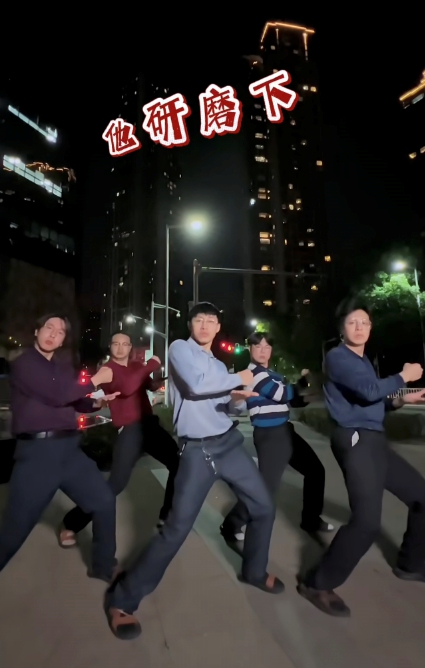Related news: How do songs of Huizhou Rapper "SKAI ISYOURGOD" suddenly go viral overseas?
"Dongjiang No.1 rode the local waves… now the No.3 crosses oceans brave." These lyrics from the freshly dropped Chinese rap track "Dongjiang No.3" depicts a ship's journey from hometown waters to the boundless deep blue. And who's piloting the "vessel?" None other than Lanlao (aka SKAI ISYOURGOD) - a 27-year-old star steering Chinese Lingnan street smarts global through his ship of rap. "Dongjiang No.3" is a track in his latest album Stacks from All Sides: Fresh off the Boat that was released on July 10.
Born in Huizhou, a small city in South China's Guangdong Province, including his breakout hit "Da Zhan Hong Tu" (lit: Blueprint Supreme), Lanlao's album Stacks from All Sides has become a cultural phenomenon, with total online views exceeding 10 billion.
What made this song a global hit wasn't rapping about guns or drugs. With his business-casual polo shirt, the artist flips Western rap convention by trading clichés for new flexes like "Phoenix Dancong tea" and "a jade pendant on the chain," weaving the unwritten street smarts of the Lingnan region, or South China, into every bar.
"I always believe the folksiest things are the coolest," Lanlao said in an interview with the Global Times on Friday, a day after he dropped his new album.
Lanlao-Style Memphis
Though Lanlao himself calls his music "folksy" and appears to be "outdated" compared to the rap world's current narratives, the artist's rap pulses with sharp social observations and Chinese street wisdom.
His stage name "Lanlao" refers to socially savvy individuals, mainly men, who manage to make money from small business by maneuvering interpersonal relationships. Another title, "Bie Laozai," also frequently appears in his music. He told the Global Times that this is Guangdong slang referring to "big-ego street loafers who are a little bit goofy."
Both the lifestyles of "Lanlao" and "Bie Laozai" have hugely inspired his music. Take his breakout hits "Da Zhan Hong Tu" and "Xingfuzhe Tuirang" (lit: Retreat in Contentment) for examples. The scenes in these works like "singing karaoke in a villa," "sitting on rosewood stools" and "trimming bonsai guest-greeting pine" accurately capture daily life on the streets of Lingnan.
"I didn't imagine these scenes. Because from a very young age, my father would take me along to his social engagements, so I saw these scenes in person," Lanlao said.
Immersion in this social culture planted the seeds of rebellion in Lanlao. He said that he hates "drinking-table culture." His music tackles these courtesies with sarcasm, guiding listeners to find a deeper philosophy of life.
The musician's lyrics are proof of his philosophical inner world. Besides simply describing mundane scenes, in his "Red Paper White Ink," Lanlao drops two lines depicting Chinese people's "humbleness" and "respect for harmony" as ways to success.
Sampling the background music from classic TV series Journey to the West, Lanlao's other song "Yin Guo," also known as "Karma Code" subtly reveals the truth that every action bears fruit, and one can only be blessed by keeping their karma rooted in good.
"I don't want to tell people directly what is good or bad, but I'll always use Chinese cultural connotations to convey my thoughts," said Lanlao, noting that his upcoming works will delve deeper into reflections on classic Chinese culture, exploring, for instance, how ancient emperors wielded decisive power and how virtuous ministers employed wisdom to govern dynamically.
This distinctive way of interpreting his native culture, combined with his command of the Memphis rap style has earned Lanlao's signature style the name "Lanlao-style Memphis."
Although Memphis rap was originally rooted in the US state of Tennessee, the Chinese rapper never found his Lingnan storytelling at odds with this foreign sound. While black rap artists use this music style to tell their street stories, Lanlao sees the Memphis style as "a vessel" for his own native cultural stories.
"No matter how far I go, I'll never leave my home culture in the cold," said Lanlao, noting that the Chinese rap world used to "chase superficial fast-flow rap," and then mimicked the so-called "cool" Western rap style, but now it has "discovered its own regional coolness."
'I won't step back'
Carrying his hometown pride, "Lanlao-style Memphis" has gone far by gaining a massive number of fans. On streaming platform Bilibili, his "Da Zhan Hong Tu" has been streamed over 3.27 million times. On Spotify, a music streaming platform popular in multiple Western countries, Lanlao's Stacks from All Sides has earned more than 3.02 million listeners monthly, topping the previous record created by Jay Chou, the all-time star of Chinese mandopop.
Currently, Lanlao's music has become a viral remix template, inspiring not only musicians but also dancers worldwide. From Chongqing, the dance group BuQi Crew has supercharged the rapper's style with their choregraphed "Da Zhan Hong Tu." On YouTube, the dance video has earned more than 3.03 million views.
In a recent interview with the Global Times, the crew's lead choreographer Liu Chang shared their music-to-dance creative process.

Members of the dance group BuQi Crew perform a choreographed dance they created based on Lanlao's "Da Zhan Hong Tu." (Photo: Courtesy of BuQi Crew)
He said that when the lyrics depict "a silver arowana swimming in a pond," the dancers mimicked the fish's undulating movement with synchronized hand motions. The line about "singing karaoke in a villa" is interpreted through a microphone-holding gesture fused with rhythmic body rolls. "Da Zhan Hong Tu" ends with a sweeping calligraphy stroke, powerful and evocative.
"We deconstructed and reassembled elements [in 'Da Zhan Hong Tu'] like Cantonese opera and calligraphy within the rhythmic flow of street dance. Our goal was to keep the moves smooth, fun, and easy to learn - lowering the barrier for global participation," Liu said.
BuQi Crew's efforts to engage global fans with Lingnan rap has paid off. Despite cultural differences, on Tiktok and YouTube, dancers from the US, Japan, Ukraine, Thailand and more have mimicked the dance moves, uploaded their own versions and further amplifying the trend. Some fans have even began learning Chinese to sing along more accurately.
Noting that he found the dance "fun," Lanlao told the Global Times that Chinese pop culture artists "bear the responsibility" of conveying local legacies globally. Such a belief is catalyzed in his July album Stacks from All Sides: Fresh off the Boat.
"The album is my response to my international recognition. A riverboat heading into the sea symbolizes a challenging task that demands step-by-step efforts. But I won't step back from it. I wouldn't be here if I detoured from my cultural roots," said Lanlao, noting that the album is like his "MVP victory recap."
With a wooden bead bracelet coiled around his wrist, Lanlao described himself as a "chill guy" and revealed to the Global Times that after the new album's release, he's granting himself a vacation, a deliberate step back from the overwhelming public spotlight.
Before becoming a rapper, Lanlao lived multiple lives, from livestreaming host for Lao Gan Ma chili sauce to drafting figures at a power plant. He told the Global Times that his ultimate dream was landing a cushy admin job at an enterprise, gradually advancing to management, clocking in at 8:30 am, then unwinding with tea, video games, and short dramas after work.
"But now I've changed, starting from knowing there are souls who truly resonate with my music has steeled my resolve to walk this path as a rapper," Lanlao noted.
'Memphis just a vessel for China's own street stories'
Editor's Note:
With his album Stacks from All Sides earning 10 billion views online worldwide, Chinese rapper Lanlao has become a global pop culture phenomenon. He fuses Lingnan folk styles with Memphis beats, allowing Chinese rap's unique indigenous identity to resonate globally. During an interview with Global Times reporter Li Yuche (GT), Lanlao shared what makes his "Lanlao-style Memphis" unique, why his rap songs value traditional Chinese culture and how he transformed from a power plant worker to a professional rapper.
GT: You are deft at creating music with the US-born rap style Memphis. What makes your "Lanlao-style Memphis" unique?
Lanlao: Memphis rap (originating in the early 1990s in Memphis, Tennessee, the US) tells the street stories of black rap artists in their own community. For example, how to carve out a place for themselves in their own cities. That essence is the same as ours, but we have our own local street stories. As someone from Guangdong Province, I've never experienced that life in the US. I'm just an ordinary guy who went to school and worked in China. That's my reality.
To me, the Memphis style is really just a music vessel. My songs are shaped by what I've seen and heard growing up. I write about the lives, customs, and philosophies of the "Guangdong folk customs" around me. I speak about what I see, pouring my life experiences into it. For example, I really need money, so I created Stacks from All Sides. When I have an idea, I jot it down, and when it's time to make a track, I revisit those notes.
GT: Why are "Guangdong folk customs" such an essential part of your rap music?
Lanlao: As a Chinese rapper, I believe it's an inevitable trend for us to expand globally by telling our own stories through music. China is home to many local cultural communities and ethnic cultures, which brings rich cultural diversity. I think promoting "regional narratives" shows the world how unique Chinese rap can be. It is also my musical goal.
Take my song "Yin Guo" as an example. It incorporates some Chinese philosophical thinking. My new album Stacks from All Sides: Fresh off the Boat is also my response to gaining popularity overseas. I want to remind people to never forget our roots while going global. Fresh off the Boat describes my overseas journey as important but challenging, and I'll go step by step. Just like the line I wrote: "Dongjiang No.1 rode the local waves, now the No.3 crosses oceans brave."
My vision for my rap music is to bring China's authentic way of life overseas. I believe that what is national is global, and regional culture is increasingly becoming the main theme in music creation.
GT: Including yourself, have you noticed that more and more Chinese rappers are valuing their homeland stories?
Lanlao: Yes, I believe this is related to the different stages of development in Chinese rap culture. In the past, we created surface-level "fast-talking" rap. Then came a phase of imitating overseas rapping trends. Now we've finally advanced to telling our own stories.
These are the different stages of Chinese rap's evolution. I think it's similar in the US, there's a central thread in rap, with many smaller branches around it. These niche sub-genres might blow up for a while and then fade, but I believe Chinese rap's homeland stories will endure and hold even more possibilities for exploration.
GT: What stereotypes or misconceptions do you think the public holds about rap culture?
Lanlao: The roots of Chinese rap are actually embedded in our traditional culture long ago. From the rhythmic patterns of classical poetry to the emergence of tongue twisters, xiangsheng (a traditional Chinese form of stand-up comedy) and more all share an innate connection with rap.
After domestic rap variety shows exploded in popularity around 2017, however, public perception narrowed rap to just "fast-talking" or a performance style beyond Shu Lai Bao (a folk art of rhythmic storytelling). This stereotype became so pervasive that even more avant-garde, experimental rap styles faced rejection.
But in truth, rap culture has always been an exceptionally inclusive genre. Today, 70 to 80 percent of pop music incorporates rap elements, proving its vitality. It was never rigid; it constantly absorbs and evolves.
GT: Before becoming a full-time rapper, you worked on various jobs. Are you more certain about this career now?
Lanlao: I studied acting in university. Rap started as a hobby. I casually wrote songs and posted them online. My original life plan was simple: find a low-pressure admin job, slowly climb to management, and coast through life comfortably. Had I not discovered rap, I'd probably be working nine-to-six now, clocking in at 8:30 am, gaming until midnight after work, watching short dramas, then sleeping.
Until one day, I realized listeners genuinely understood what my lyrics aimed to express. That sense of being understood made me feel my work had value - and that I now bear a responsibility to share Chinese culture with the world through rap music.
GT: What are your creative moves for the future?
Lanlao: Moving forward, my music will delve deeper into the lived experiences of middle-aged groups. I will use sarcasm as the core artistic thread to depict these people's lives.
Also, I want to share with you that I'll weave more elements of traditional Chinese studies into my music, such as referencing classical texts and historical stories.
For example, I'm exploring themes like strategists advising rulers, and emperors making pivotal decisions in ancient societies. Right now, though, my research is still scratching the surface - I need more reflection and study.
But one thing is certain: I can no longer make catchy but shallow music because my position is now a rapper from China on the world stage.
















